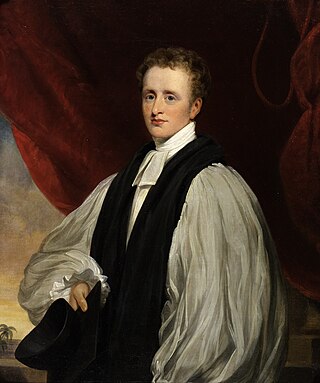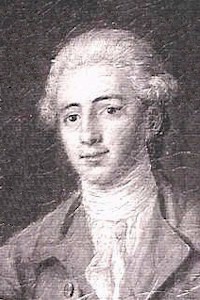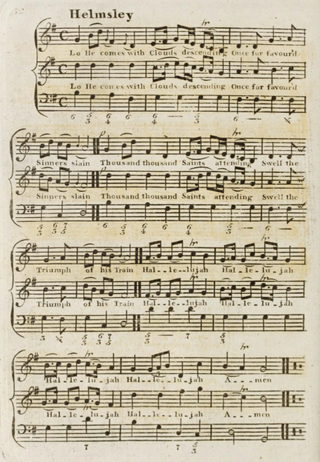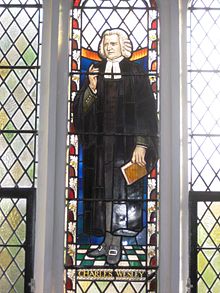
A hymnal or hymnary is a collection of hymns, usually in the form of a book, called a hymnbook. They are used in congregational singing. A hymnal may contain only hymn texts ; written melodies are extra, and more recently harmony parts have also been provided.

The hymn "When I Survey the Wondrous Cross" was written by Isaac Watts, and published in Hymns and Spiritual Songs in 1707. It is significant for being an innovative departure from the early English hymn style of only using paraphrased biblical texts, although the first couplet of the second verse paraphrases Galatians 6:14a and the second couplet of the fourth verse paraphrases Gal. 6:14b. The poetry of "When I survey…" may be seen as English literary baroque.

"Love Divine, All Loves Excelling" is a Christian hymn by Charles Wesley on Christian perfection. Judging by general repute, it is among Wesley's finest. Judging by its distribution, it is also among his most successful.

"O for a Thousand Tongues to Sing" is a Christian hymn written by Charles Wesley. The hymn was placed first in John Wesley's A Collection of Hymns for the People Called Methodists published in 1780. It was the first hymn in every (Wesleyan) Methodist hymnal from that time until the publication of Hymns and Psalms in 1983.

"Christ the Lord Is Risen Today" is a Christian hymn associated with Easter. Most of the stanzas were written by Charles Wesley, and the hymn appeared under the title "Hymn for Easter Day" in Hymns and Sacred Poems by Charles and John Wesley in 1739. The hymn eventually became well known for the "Alleluia" sung as a melisma after each line, which was added by an unknown author, probably to fit the commonly used hymn tune, "Easter Hymn". It remains a traditional processional hymn on Easter Sunday.

"Rock of Ages" is a popular Christian hymn written by the Reformed Anglican minister Augustus Toplady.

Robert Lowry was an American preacher who became a popular writer of gospel music in the mid- to late-19th century. His best-known hymns include "Shall We Gather at the River", "Christ Arose!", "How Can I Keep from Singing?" and "Nothing But The Blood Of Jesus".

Hymns Ancient and Modern is a hymnal in common use within the Church of England, a result of the efforts of the Oxford Movement. The hymnal was first published in 1861. The organization publishing it has now been formed into a charitable trust, Hymns Ancient and Modern Ltd, and As of 2022 it publishes a wide range of hymnals as well as other theological and religious books and magazines, under imprints including the acquired publishers Canterbury Press and SCM Press.

"Holy, Holy, Holy! Lord God Almighty!" is a Christian hymn written by the Anglican bishop Reginald Heber (1783–1826).

"All Hail the Power of Jesus' Name" is a Christian hymn.
Hymnology is the scholarly study of religious song, or the hymn, in its many aspects, with particular focus on choral and congregational song. It may be more or less clearly distinguished from hymnody, the creation and practice of such song. Hymnologists, such as Erik Routley, may study the history and origins of hymns and of traditions of sung worship, the biographies of the women and men who have written hymns that have passed into choral or congregational use, the interrelationships between text and tune, the historical processes, both folk and redactional, that have changed hymn texts and hymn tunes over time, and the sociopolitical, theological and aesthetic arguments concerning various styles of sung worship.

Thine Be the Glory, Risen Conquering Son, also titled Thine Is the Glory, is a Christian hymn for Easter, written by the Swiss Protestant minister, Edmond Budry (1854–1932), and set to the tune of the chorus "See, the Conqu'ring hero comes" from the third section of Handel's oratorio Judas Maccabaeus. The hymn is sometimes sung at weddings or funerals.

"Soldiers of Christ, Arise" is an 18th-century English hymn. The words were written by Charles Wesley (1707–1788), and the first line refers to the armour of God in Ephesians 6:10–18.

"Come, Thou Long Expected Jesus" is a 1744 Advent and Christmas carol common in Protestant hymnals. The text was written by Charles Wesley. It is performed to one of several tunes, including "Stuttgart", "Hyfrydol", and "Cross of Jesus". The hymn is considered an enduring classic in Christian hymnody.
"The Summons", also called "Will You Come and Follow Me", is a Scottish Christian hymn. It was written by John L. Bell in 1987.

"All for Jesus, All for Jesus", also titled as "All for Jesus! All for Jesus!" and originally titled "For the Love of Jesus", is an English Christian hymn. It was written in 1887 by W J Sparrow Simpson intended as the closing chorus of John Stainer's The Crucifixion oratorio. It started to be published as a separate hymn later in 1901.

"O'er the Gloomy Hills of Darkness", also titled "O'er Those Gloomy Hills of Darkness", is a Welsh Christian hymn by William Williams Pantycelyn written in 1772. The hymn was written as a missionary hymn; there are conflicting accounts of why the hymn was written. The hymn was later published in 374 hymnals worldwide, though it was censored and altered in the United States by slaveholders for evangelising to slaves. The hymn later fell out of favour with hymn book editors in the 1960s.

"Lo! He comes with clouds descending" is a Christian hymn by Charles Wesley (1707–1788), based on an earlier hymn, "Lo! He cometh, countless Trumpets" by John Cennick (1718–1755). Most commonly sung at Advent, the hymn derives its theological content from the Book of Revelation relating imagery of the Day of Judgment. Considered one of the "Great Four Anglican Hymns" in the 19th century, it is most commonly sung to the tune Helmsley, first published in 1763.
"Let us break bread together" is a traditional Christian hymn. Its melody is searching, simple, major key, and has simple lyrics.
















